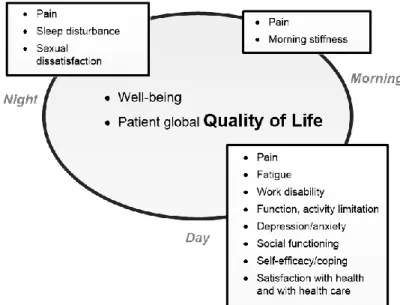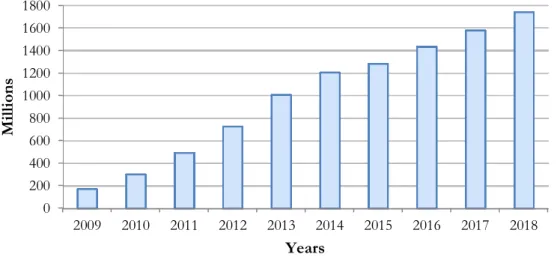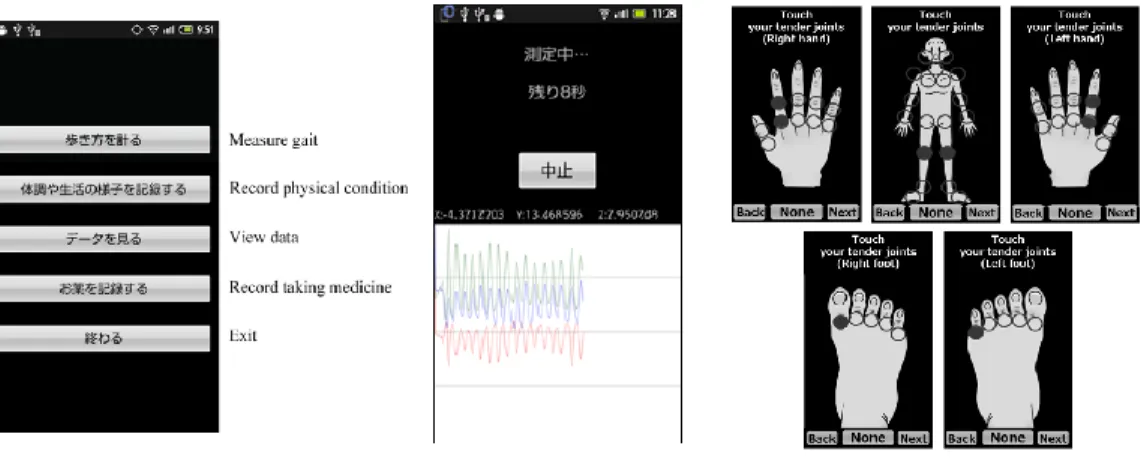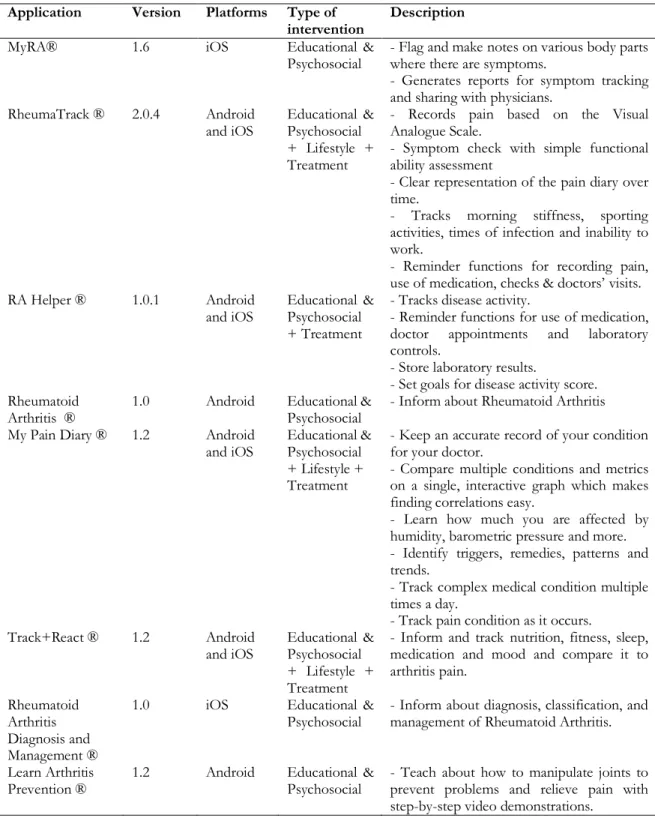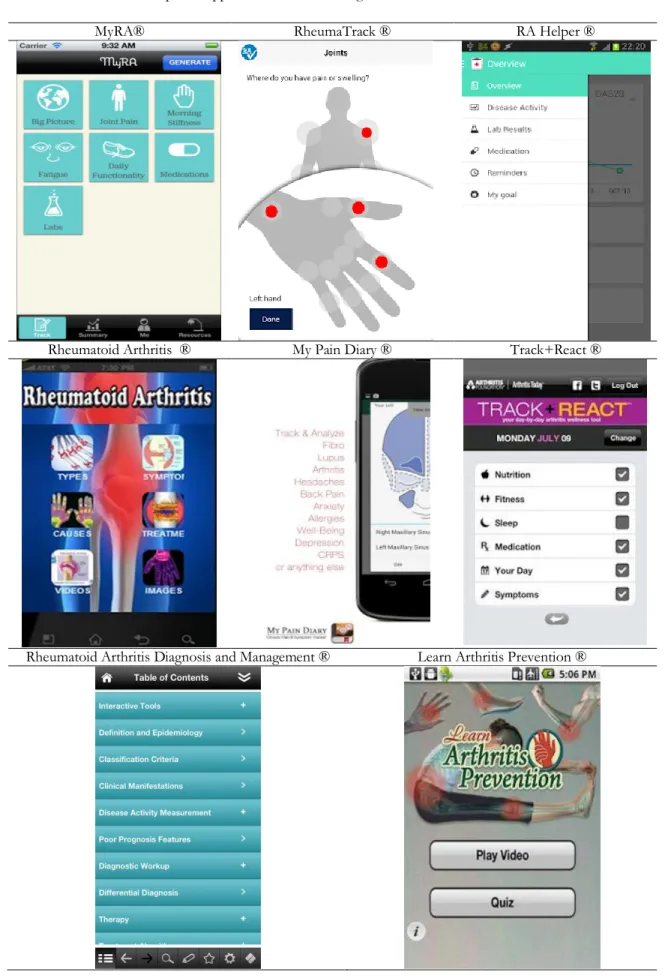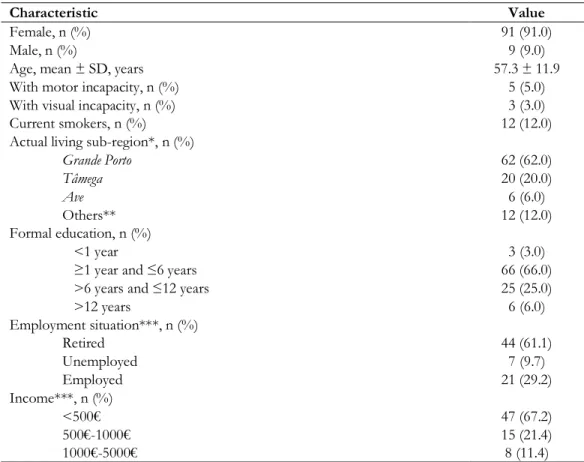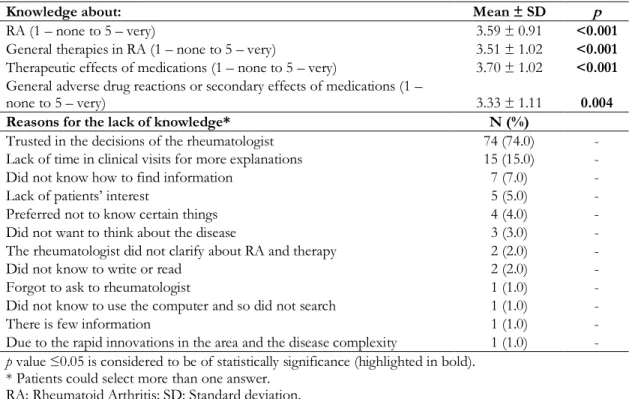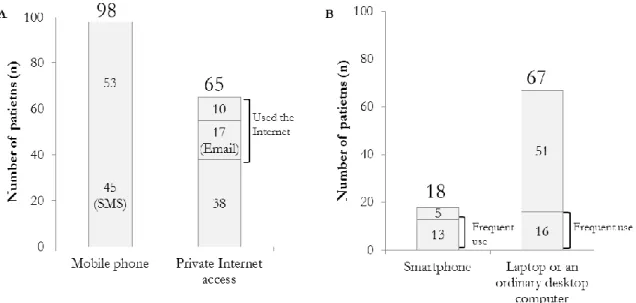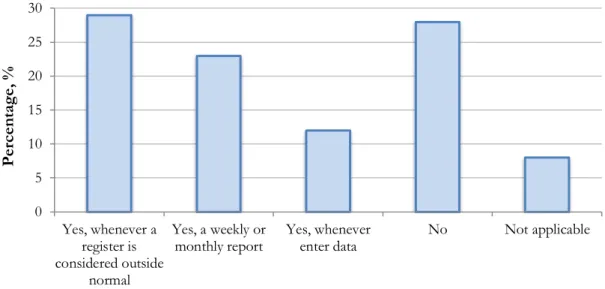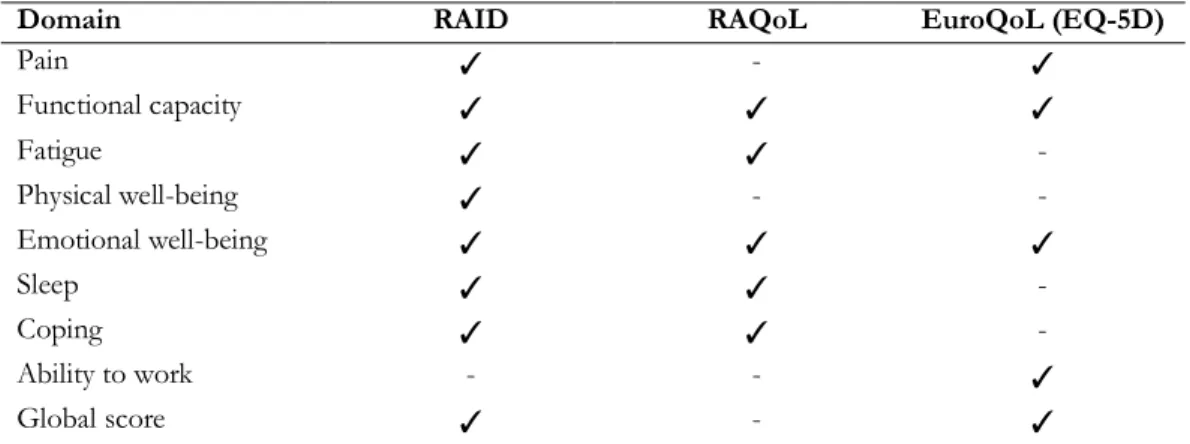v
Preliminary Note
I hereby declare that the work presented in this dissertation is my own work and that, to the best of my knowledge and belief, it contains original material, i.e. material that was not previously published or written by another person, or material accepted for any other degree or diploma of this university or any other institution of higher learning.
Porto, 6th August 2014
_____________________________________ Ana Rita Pereira Azevedo
This dissertation has the collaboration of Faculty of Medicine of University of Porto
(Faculdade de Medicina da Universidade do Porto), Rheumatology Service of the São João Hospital Center (Serviço de Reumatologia do Centro Hospitalar de São João), Molecular Oncology Group of the Portuguese Institute of Oncology – Porto (Grupo de Oncologia Molecular do
Instituto Português de Oncologia – Porto) and Higher Institute of Health Sciences – North (Instituto Superior de Ciências da Saúde – Norte).
vii
Acknowledgments
I would like to express my gratitude and heartfelt thanks to my supervisors João Fonseca (MD., Ph.D.) and Áurea Lima (PharmD., M.Sc., Ph.D.) for their guidance, motivation, rapid feedback and kindness throughout my dissertation. I could not do much without your guidance and support.
I would like to demonstrate my sincere recognition to Áurea Lima (PharmD., M.Sc., Ph.D.) not only for her guidance of the highest scientific level, with constructive and priceless suggestions that helped me to reach this achievement, but for her friendship and availability for anything I neededeven in the most difficult moments. Your support was invaluable and key for the success of this dissertation.You are a true inspiration of what I want myself to becomeprofessionally.Thanks for everything!
I am very grateful to Miguel Bernardes (MD., M.Sc.) for his role as an intermediary between me and patients with Rheumatoid Arthritis in Rheumatology Service, which has always played very competently, and for his kindness and willingness to help me during the development of the questionnaire and the application interface. Also would like to demonstrate my gratitude to Alexandra Bernardo (MD.) and to the nurses of the
Rheumatology Service for their sympathy and help. Your help was inestimable. Thank you all!
I am thankful to Hugo Sousa (MD., Ph.D.) and Joaquim Monteiro (PharmD., Ph.D.) for their help with the development of the questionnaire and the review article. Your help was indispensable for the development of this dissertation.
I am thankful to people who participated in this study for their responses and cooperation. Your response to my questionnaire was important to the success of this dissertation.
I also take this opportunity to thanks my friends and colleagues for their support and feedback throughout my dissertation. Also I would like to thanks to Ricardo Correia (Ph.D.) for his rapid explanation about the phases this work should include and kindness to introduce me to my supervisor, which has a great knowledge about Smartphone applications development in health. I thank you all.
ix
Abstract
Introduction: Rheumatoid Arthritis (RA) is a chronic disease where self-management interventions are essential components of care to reduce RA burden. Smartphones have the potential to support in self-management tasks partly due to their ubiquity, portability, connectivity and capabilities.
Objectives: The main objective of this work was to develop a Smartphone application for supporting in RA self-management of Portuguese RA patients.
This work was divided in the following studies:
Study 1: A literature review was conducted to analyze the actual state of the art of Smartphone applications for RA self-management and revealed that research on development of such applications is sparse and there is none for Portuguese patients.
Study 2: A descriptive cross-sectional study was conducted with 100 patients with RA. A questionnaire was developed for the analysis of theusefulness of a RA self-management application, patients’ willingness to use and pay for it and the features the application should have. Descriptive statistical analyses and one sample t tests were performed. This study included more females (91.0%) and the mean age of the population was 57.3 ± 11.9 years. Patients reported having fear of disease lack of control (p=0.038), difficulty in dealing with feelings of sadness (p=0.005) and a bad global health (p<0.001). They presented multiple drug regimens (number of RA medications of 5.0 (2.0-15.0)) and a non-compliance rate of 40.0% mainly due to forgetfulness (67.5%). Ninety-four patients
(94.0%) believed that they could have a more active role in self-management. Most patients (86%) reported it would be useful to develop a RA self-management application. Eighty-three percent of patients were willing to use a RA self-management application and 82% were willing to pay for it. The most cited features for self-management were information about disease and treatment and monitoring of disease and quality of life over time.
Study 3: The development of the Smartphone application – “Diário da AR” - included the steps of definition of functional requirements using the questionnaire’s results and literature review, and non-functional requirements, creation of use-cases diagrams, event list and, identification of system stakeholders and interface design. The “Diário da AR” should allow long-term recording and monitoring disease activity, provide step-by-step advices for living better with RA, alerts for taking medication or other tasks, register adverse drug reactions and enable viewing past actions and sharing.
Conclusion: This study suggests the usefulness and patients’ willingness to use and pay for a RA self-management application and provides insight on patients’ needs. Overall, the application has potential to be an innovative medium to endow patients to develop self-management skills.
xi
Resumo
Introdução: A artrite reumatoide (AR) é uma doença crónica na qual as intervenções de autogestão são componentes essenciais de saúde para reduzir o impacto desta doença. Os
Smartphones têm potencial para auxiliar nas tarefas de autogestão, em parte devido à
ubiquidade, portabilidade, conectividade e capacidades destes dispositivos.
Objetivos: O objetivo principal deste trabalho foi desenvolver uma aplicação para
Smartphone para auxiliar na autogestão da AR pelos Portugueses com esta doença.
Este trabalho foi dividido nos seguintes estudos:
Estudo 1:Uma revisão da literatura foi realizada para analisar o estado atual da arte de aplicações para Smartphone para a autogestão da AR e revelou que a investigação sobre o desenvolvimento destas aplicações é escassa e não existe nenhuma aplicação deste tipo para os Portugueses com AR.
Estudo 2: Um estudo transversal descritivo foi realizado com 100 doentes com AR. Foi elaborado um questionário para a análise da utilidade de uma aplicação Smartphone para a autogestão da AR, da predisposição dos doentes para usar e pagar por esta e as
características que a aplicação deverá ter. Foram efetuadas análises estatísticas descritivas e testes t de uma amostra. Este estudo incluiu mais mulheres (91,0%) e a idade média da população foi de 57,3 ± 11,9 anos. Os doentes referiram terem medo da perda de controlo sobre a doença (p=0,038), dificuldade em lidar com sentimentos de tristeza (p=0,005), e avaliaram a sua saúde global como má (p<0,001). A população apresentou regimes terapêuticos múltiplos (número de medicamentos para a AR de 5,0 (2,0-15,0)) e uma taxa de não adesão à terapêutica de 40,0%, principalmente devido a esquecimento (67,5%). Noventa e quatro doentes (94,0%) acreditavam que poderiam ter um papel mais ativo na autogestão da sua doença. A maioria dos doentes (86%) achavam útil desenvolver uma aplicação de autogestão da AR. Oitenta e três por cento estavam dispostos a utilizar uma aplicação de autogestão da AR e 82% pagariam por esta. As características mais citadas para a autogestão foram a informação sobre a doença e tratamento e a monitorização da doença e da qualidade de vida ao longo do tempo.
Estudo 3: O desenvolvimento da aplicação Smartphone – “Diário da AR” - incluiu as etapas de definição de requisitos funcionais, usando os resultados do questionário e a revisão da literatura, e de requisitos não-funcionais, criação de diagramas casos-uso e lista de eventos, identificação dos stakeholders do sistema e design da interface. O “Diário da AR” deverá permitir monitorizar e guardar a atividade da doença a longo-termo, fornecer conselhos passo-a-passo para viver melhor com AR e alertas para tomar a medicação ou outras tarefas, registar reações adversas de medicamentos e permitir a visualização do histórico e partilhar.
xii
usar e pagar por uma aplicação Smartphone para auxiliar na autogestão da RA e fornece informação sobre as necessidades dos doentes. No geral, a aplicação tem potencial para ser um meio inovador para dotar os doentes a desenvolver capacidades de autogestão.
xiii
Preamble
Using mobile phones for health-related purposes have been studied for some years now and new concepts such as mobile health have been introduced. Mobile health is believed to have a great potential in taking health-related applications to a higher level especially with the introduction of the Smartphones.The ubiquitous nature of Smartphones, the
advantages of being personal, portable, connected, intuitive and computationally powerful, and the capability to support applications (“apps”), highlights the need to explore this technology as a way of assisting with the adoption and maintenance of self-management behaviors.
Self-management, a subset of self-care, is defined as a decision to be actively involved in managing a disease and develop practical skills to effectively self-manage. Self-management interventions are a key factor in Rheumatoid Arthritis due to the chronic and progressive character of this disease. Recent literature suggests that traditional self-management interventions can empower Rheumatoid Arthritis patients to become effective health-care consumers in addition to improving clinical outcomes. Although and despite all the advantages, at this moment, research relating to the development and evaluation of Smartphone applications for Rheumatoid Arthritis self-management is sparse. In addition, there are any applications in Portuguese from Portugal for this purpose. In this context, emerged the idea of develop a Smartphone application for supporting in Rheumatoid Arthritis self-management by Portuguese with this disease.
The structure of this dissertation is divided as follows: Chapter 1. Introduction
This introductory chapter provides a brief description of Rheumatoid Arthritis, explains the role of self-management interventions in this disease, and exploits the applicability of Smartphone applications for Rheumatoid Arthritis self-management.
Chapter 2. Objectives
This chapter presents the main and secondary objectives of this work. Chapter 3. Justification
This chapter describes all the facts and knowledge that supported/justified this investigation work arising from the literature review.
Chapter 4. Study 1: Literature review
xiv
applications for RA self-management and includes all the information about the search strategy and its results.
Chapter 5. Study 2: Needs assessment
This chapter describes the methodology used for the realization of the questionnaire and the results obtained from the questionnaire’s analysis.
Chapter 6. Study 3: Development of a Smartphone application
This chapter provides the description of the stages of Smartphone application development.
Chapter 7. General conclusion
This chapter presents the general conclusions of this work. Chapter 8. Future Work
xv
Scientific and Financial Results
With regard to scientific contributions, the following papers were submitted to a scientific journal with international circulation:
Rita Azevedo, Hugo Sousa, Joaquim Monteiro, Aurea Lima. Future perspectives of
Smartphone applications for rheumatic diseases self-management. Rheumatology
International. 2014. doi: 10.1007/s00296-014-3117-9. Review article. [Published]
Rita Azevedo, Miguel Bernardes, João Fonseca, Aurea Lima. Smartphone
application for Rheumatoid Arthritis self-management: cross-sectional study revealed the usefulness, willingness to use and patients’ needs. 2014. Original article. [Submitted]
The idea of this M.Sc. work was submitted to the 5th edition of the “Fraunhofer
Portugal Challenge”, an idea contest promoted by Fraunhofer AICOS with the objective of motivating and rewarding research of practical utility, through the attribution of a scientific prize to M.Sc./Ph.D. Students and Researchers from Portuguese Universities in the areas of ICT, Multimedia and other related Sciences. The idea reached to 2nd phase (in 3 phases) of this challenge.
The work of this dissertation did not received financial or scientific funding from any organization.
xvii
Table of Contents
Preliminary Note ... v Acknowledgments ... vii Abstract ... ix Resumo ... xi Preamble ... xiiiScientific and Financial Results ... xv
Table of Contents ... xvii
List of Tables ... xix
List of Figures ... xxi
Acronyms & Abbreviations ... xxiii
1. Introduction ... 1
1.1 Rheumatoid Arthritis...3
1.2 Self-management interventions ...5
1.3 Smartphones in self-management ...7
1.3.1 Smartphone: An Emerging Technology in Health ...7
1.3.2 Importance of Smartphone Applications for Self-management ...9
2. Objectives ... 11
3. Justification ... 15
4. Study 1: Literature review ... 19
4.1 Search strategy & selection criteria ... 21
4.2 Results ... 21
4.2.1 Literature ... 22
4.2.2 Application’s online stores... 23
4.3 Discussion ... 25
5. Study 2: Needs assessment ... 27
5.1 Methodology... 29
5.1.1 Study design & population ... 29
5.1.2 Data collection... 29 5.1.3 Statistical Analysis ... 30 5.2 Results ... 31 5.2.1 Study population ... 31 5.2.2 Relation patient-disease ... 31 5.2.3 Relation patient-treatment ... 32 5.2.4 Relation patient-rheumatologist ... 33 5.2.5 Patients’ knowledge ... 33 5.2.6 Relation patient-self-management ... 33 5.2.7 Relation patient-technology ... 34
5.2.8 Perception of usefulness & willingness to use and pay for a RA self-management application ... 35
xviii
5.3 Discussion ... 36 6. Study 3: Development of a Smartphone application ... 39 6.1 Requirements & Analysis ... 41 6.1.1 Functional requirements ... 41 6.1.2 Event list ... 45 6.1.3 System stakeholders ... 49 6.1.4 Use-case diagrams ... 49 6.1.5 Non-functional requirements ... 52 6.2 Design ... 53 6.2.1 System architecture ... 53 6.2.2 Screens for profile’s creation/edition ... 54 6.2.3 Screens for disease management ... 55 6.2.4 Screens for medication ... 58 6.2.5 Screens for information ... 60 6.2.6 Screens for health questionnaire ... 60 6.2.7 Screens for historical ... 61 6.2.8 Screens for options ... 61 6.3 Implementation & Testing ... 62 6.4 Discussion ... 62 7. General conclusion ... 65 8. Future Work ... 69 8.1 Application testing ... 71 8.2 Effectiveness evaluation ... 72 8.3 Extension for others OS ... 72 8.4 Application improvement ... 72 8.4.1 Gait pattern measure ... 72 8.4.2 Detection of drug interactions ... 73 8.4.3 Advices and track physical activity ... 73 8.4.4 Goal setting ... 73 8.4.5 Contacting peers ... 73 8.5 Extension for others languages ... 74 8.6 Integration with the Hospital Information System... 74 9. References ... 75 10. Annexes ... 87 10.1 Review article about the importance of developing a Smartphone application for Rheumatic Diseases self-management ... 91 10.2 Proof of acceptance by the Ethics Committee for Health of São João Hospital Center/Faculty of Medicine of University of Porto ... 107 10.3 Information about the study delivered before the questionnaire ... 115 10.4 Informed consent according to the Declaration of Helsinki ... 121 10.5 Questionnaire delivered to RA patients ... 125 10.6 Portuguese versions of HAQ-DI and RAID ... 131 10.7 Text on the “Diário da AR” application screens... 137 10.8 Application usability and usefulness questionnaire ... 145
xix
List of Tables
Table 1. Reasons for non-compliance ... 4 Table 2. Smartphone applications for self-management of Rheumatoid Arthritis
in online stores ... 23 Table 3. Screens of Smartphone applications for self-management of Rheumatoid
Arthritis in online stores ... 24 Table 4. Sociodemographic characteristics of the studied population ... 31 Table 5. Disease and treatment characteristics of the studied population ... 32 Table 6. Attitudes in relation to medication and reasons for non-compliance ... 32 Table 7. Knowledge and reasons for the lack of knowledge about the disease and
therapy ... 33 Table 8. Most important features to support RA self- management ... 35 Table 9. Health domains assessed by disease impact questionnaires in Rheumatoid
Arthritis ... 43 Table 10.“Diário da AR” application characteristics ... 45 Table 11. Event list ... 46
xxi
List of Figures
Figure 1. Most important health domains for Rheumatoid Arthritis patients ... 5 Figure 2. Self-management interventions in Rheumatoid Arthritis ... 6 Figure 3. Global Smartphone shipments from 2009 to 2014 (in million units) and
forecast until 2018 ... 8 Figure 4. Sharing system overview ... 22 Figure 5. Technology ownership and patient-relation with it ... 34 Figure 6. Answers to the question “Would you like if the application could send an
automatic notification of your inputted data to the rheumatologist?” ... 36 Figure 7. Waterfall model development cycle ... 41 Figure 8. Use-case diagram representative of profile’s creation and edition after the
first time the application is started and the pin protection is enabled. ... 50 Figure 9. Use-case diagram representative of “Disease Management” section ... 51 Figure 10. Use-case diagram representative of “Options” section ... 52 Figure 11. System Architecture ... 54 Figure 12. Application launch and notification box for profile’s creation at first time
application is started ... 54 Figure 13. Profile’s creation/edition screens ... 55 Figure 14. Main menu screen (Left) and “Disease Management” screen (Right) ... 56 Figure 15. “Functional Impact” screens ... 56 Figure 16. “Functional Impact” result’s screen ... 57 Figure 17. “Clinical visits and other tasks” screens ... 57 Figure 18. “Practical advices” screens ... 58 Figure 19. “Medication” screens for add/edit medications ... 59 Figure 20. Notification box for take the medications (left) and screen for editing
medication status (right) ... 59 Figure 21. Adverse drug reactions registry screen ... 59 Figure 22. “Information” screens... 60 Figure 23. “Health questionnaire” screens ... 61 Figure 24. “Historical” screens ... 61 Figure 25. “Options” screens ... 62
xxiii
Acronyms & Abbreviations
3G Third GenerationACR American College of Rheumatology ADR Adverse Drug Reactions
ADT Android Development Tools API Application Programming Interface b/min Beats for Minute
DAS28 Disease Activity Index 28
EQ-5D European Quality of Life Five Dimensions EULAR European League Against Rheumatism EuroQoL European Quality of Life
HAQ Health Assessment Questionnaire
HAQ-DI Health Assessment Questionnaire - Disability Index IDE Integrated Development Environment
JDK Java SE Development Kit kg Kilogram
m Meter
mg/dl Milligrams for Deciliter mHealth Mobile Health
mmHg Millimeters of Mercury
NUTS III Nomenclatura Comum das Unidades Territoriais Estatísticas – Nível III OS Operating System
PDF Portable Document Format RA Rheumatoid Arthritis
RAID Rheumatoid Arthritis Impact of Disease RAQoL Rheumatoid Arthritis Quality of Life SD Standard Deviation
SDK Software Development Kit SMS Short Message Service UML Unified Modelling Language URL Uniform Resource Locator VAS Visual Analog Scale
Introduction 3
1. Introduction
This introductory chapter provides a brief description of Rheumatoid Arthritis, explains the role of self-management interventions in this disease, and exploits the applicability of Smartphone applications for Rheumatoid Arthritis self-management.
1.1 Rheumatoid Arthritis
Rheumatoid Arthritis (RA) is a complex, systemic autoimmune disease, typically
characterized by a chronic and symmetric inflammation of multiple peripheral joints, which leads to destruction of cartilage and bone, progressive deformity and severe disability (Imboden et al., 2006; Smith et al., 2011).
The worldwide prevalence of RA is relatively constant ranging from 0.3% to 1.1% (Myasoedova et al., 2010; Silman & Pearson, 2002) and the incidence rates vary from 9 to 60 cases per 100.000 inhabitants (Carbonell et al., 2008; Myasoedova et al., 2010). In Portugal, the prevalence of this disease is 0.36% and the incidence is not known, still should follow the same trend of Southern European countries (9 to 24 cases per 100 000 inhabitants) (Branco & Canhao, 2011; Carbonell et al., 2008). RA affects more the feminine gender, with a gender ratio from about 2:1 to 3:1 (Alamanos & Drosos, 2005), and the peak disease onset occurs at the fifth decade of life (Rindfleisch & Muller, 2005).
RA usually affects up to 80% of patients within one year of diagnosis (Aletaha et al., 2010; McInnes & Schett, 2011). The distinct pattern of bone and joint destruction is translated in pain, stiffness (worse in morning) and swelling of involved joints, which difficult the routine activities (Imboden et al., 2006; Smith et al., 2011). In fact, RA patients are less physically active than general population (Hootman et al., 2003). Nevertheless, physical activity is crucial for maintain physical health and wellness and reduce pain (Cooney et al., 2011; Vliet Vlieland & van den Ende, 2011), which is positively related to several psychological factors (e.g. self-esteem, pain coping and self-efficacy) (Creamer et al., 1999). Additionally, there is also a persistent systemic inflammatory state present that may promote a number of other extra-articular manifestations such as lung fibrosis,
osteoporosis, rheumatoid nodules, infections and cardiovascular, hematologic and gastrointestinal diseases (Smith et al., 2011; Tobon et al., 2010). These systemic
complications related to the underlying disease process impact the average life expectancy of patients with RA, which is reduced by ten years in the female gender whereas in male gender is diminished by four years, and are responsible for increased morbidity (Akil & Amos, 1995). No less important is the fact that about 20% of patients with RA have approximately 2-fold to 4-fold higher risk of developing affective disorders (e.g. depression and anxiety) than general population (Margaretten et al., 2011).
4 Introduction
Given the characteristics of RA, there is a need for patient's long-term monitoring in order to minimize the negative impact of the disease on patient's quality of life (Rindfleisch & Muller, 2005). There are several patient-centered methods used for self-monitoring the disease that take into account the quantification of the disease activity, and of the health-related quality of life impact (Bruce & Fries, 2003; Leeb et al., 2008). The ability to effectively measure health-related quality of life longitudinally is central to describing the impact of disease or treatment (Bruce & Fries, 2003).
RA affects not only the patient but also the society in general, since the disease
represents great economic losses mostly caused by work withdrawal due to failure or pain associated with the disease, loss of work productivity and constant use of health care services (Kvien, 2004).
An earlier detection of RA, a rapid effective therapeutic institution and treatment compliance are crucial factors to achieve the disease remission (Smolen et al., 2014). Nevertheless, treatment non-compliance is a common, complex and costly problem in RA (Elliott, 2008; Neame & Hammond, 2005; van den Bemt et al., 2009; van den Bemt & van Lankveld, 2007). In fact, average non-compliance rate to chronic medication therapy is about 50%, mostly because RA is a chronic condition that often requires multiple drug regimens (Iihara et al., 2004; van den Bemt et al., 2009). Non-compliance can be intentional or unintentional and is influenced by patient characteristics (e.g. educational levels and socioeconomic levels), treatment factors (e.g. multiple drug regimens and chronic
medication) and patient-rheumatologist issues (Elliott, 2008; Neame & Hammond, 2005). Intentional non-compliance reflects a rational decision-making process by the patient to not take the drugs or make a different dosage as instructed based on perceptions, feelings or beliefs that drugs will not relieve symptoms, improve quality of life and/or will cause adverse drug reactions (ADRs) or dependence (Elliott, 2008; Lehane & McCarthy, 2007; Neame & Hammond, 2005). On the other hand, unintentional non-compliance involves intending to take a medication as instructed but failing to do so for some reason (e.g. forgetfulness or carelessness) (Elliott, 2008; Neame & Hammond, 2005). The unintentional non-compliance is the most common type of non-compliance (Table 1) (Wilson Health Information & The J. Scott Group, 2006).
Table 1. Reasons for non-compliance
%
Unintentional
Forgot to take 79.0
Ran out of medication 19.0
Intentional
Too costly 9.0
Patient-perceived lack of need 9.0
Side effects 7.0
No improvement seen 3.0
Adapted from reference (Wilson Health Information & The J. Scott Group, 2006)
Introduction 5
RA treatment is not only based in pharmacologic strategies. Nowadays, the large
majority of patients have been told to try at least one type of non-pharmacologic treatment, such exercise therapy, physical modalities (e.g. thermotherapy and massage) and
self-management interventions (Li et al., 2004).
1.2 Self-management interventions
Self-management has been defined as the “patient ability to manage the symptoms, treatment, physical and psychosocial consequences and lifestyle changes inherent in living with a chronic condition” (Barlow et al., 2002). It is characterized by several
subcomponents such as education (e.g. goal setting and problem solving), self-monitoring, self-measurement, self-evaluation, self-treatment and self-comparison.
Self-management interventions, besides being problem-focused and action-oriented, emphasize patient-centered care plans that include educational, behavioral and cognitive approaches, in order to influence health knowledge, attitudes, beliefs and behaviors (K. R. Lorig & Holman, 2003). These are seen as key components of rheumatologic care (Kendall
et al., 2011), aimed to directly and/or indirectly improve health-related quality of life of the
most important health domains for RA patients (e.g. pain, disability, depression and global disease severity (Figure 1)), healthcare utilization (total clinical visits to physicians and rheumatology-related visits) and perceived self-efficacy (reflection of patient confidence to exercise control over the disease) (Goeppinger et al., 2007; Nour et al., 2006, 2007; Patel et
al., 2009). To achieve these patient- and healthcare-related improvements, RA
self-management interventions cover several subjects, as follow: 1) educational and psychosocial interventions; 2) lifestyle interventions; and, 3) treatment interventions (Figure 2) (Goeppinger et al., 2007; Goeppinger et al., 2009; K. Lorig et al., 2005; K. R. Lorig & Holman, 2003; K. R. Lorig et al., 2008; Nour et al., 2006, 2007; Patel et al., 2009).
Figure 1. Most important health domains for Rheumatoid Arthritis patients. Adapted from reference (Laure Gossec, 2010).
6 Introduction F ig ur e2 . Se lf -m an ag em en t i nt erv en tio ns in R he um at oi d A rt hri tis .
Introduction 7
Recent literature suggests that traditional RA self-management interventions such as face-to-face or internet-delivered can empower patients to become effective health-care consumers in addition to improving clinical outcomes (Bernatsky et al., 2012; Dures & Hewlett, 2012; Foster et al., 2007; Garnefski et al., 2013; Goeppinger et al., 2007;
Goeppinger et al., 2009; K. Lorig et al., 2005; K. R. Lorig et al., 2008; Nour et al., 2006, 2007; Patel et al., 2009; Reid et al., 2008). In addition, these programs are both important and satisfying to patients (K. R. Lorig et al., 2001). Nevertheless, there are several problems in these self-management interventions that include the difficulty in involving patients, physicians and organizations; issues in evaluating them; and, their limited success both in terms of content, timing and economic and social impacts (Glasgow et al., 2008; Kendall et
al., 2011; Lind-Albrecht, 2006; Riemsma et al., 2004) (Subchapter 1.3.2 Importance of
Smartphone Applications for Self-management). One economically and socially viable solution to mitigate some of these problems is exploiting the benefits of modern
technologies, using Smartphone applications.
1.3 Smartphones in self-management
Internet technologies have yielded advances in telemedicine and teleHealth and, subsequently, are now used in every modern health care organizations (Mariani & Pego-Fernandes, 2012). Due to the advances of these technologies, barriers of space and time between healthcare providers and patients have been broken and a new term in the field of teleHealth emerged: mobile health (mHealth) (El Khaddar et al., 2012). As defined by the World Health Organization (WHO), mHealth, a component of electronic health (eHealth), is a “medical and public health practice supported by mobile devices, such as mobile phones, patient monitoring devices, personal digital assistants and other wireless devices” (Martinez-Perez et al., 2013). Although personal digital assistants experienced a growth between 1990s and early 2000s, they have been replaced by other mobile devices with new functions and utilities, such as Smartphones (Martinez-Perez et al., 2013).
1.3.1 Smartphone: An Emerging Technology in Health
Smartphones are defined as mobile telephones with computer features that may enable them to interact with computerized systems, send e-mails and access the web (Mosa et al., 2012). The Smartphone market is growing quickly and there are already more than 1.20 billion Smartphones of a total of 5 billion mobile phones around the world, with women taking the lead (56% owning a Smartphone) (Figure 3) (GO-Gulf.com Web Design Company, 2012; Mosa et al., 2012; Oglivy Action, 2012; Statista, 2014). These have the advantages of being personal, intuitive, user-friendly, computationally powerful, with larger and higher resolution display screens, sensor-rich (e.g. high quality cameras, recording devices, accelerometers and geo-positioning systems), connected and portable (Fogg & Adler, 2009; Patrick et al., 2008). The internal sensors offer diverse possibilities such the ability to infer context (user location, movement and emotion) and the connectedness facilitates the sharing of health data with health professionals or peers (Patrick et al., 2008).
8 Introduction
As portable devices, they are highly valued by individuals, tend to be switched on and, remain with the owner throughout the day and everywhere, which offers the opportunity of bring interventions into real life context (Patrick et al., 2008; Venta et al., 2008).
Moreover, the capability of Smartphones to support software programs, known as applications (“apps”), has stimulated significant attention in recent years and since Smartphones global acceptance is increasing quickly, there is a great opportunity for mHealth in using these applications.
Figure 3. Global Smartphone shipments from 2009 to 2014 (in million units) and forecast until 2018. Adapted from reference (Statista, 2014).
Similarly to Smartphone owing, women take the lead when it comes to using health applications, with greater use in certain life events (e.g. pregnancy) (Oglivy Action, 2012; Rotheram-Borus et al., 2012). There is already a growing body of evidence that supports the use of Smartphone applications in health interventions. Many thousands of commercial applications may provide cheaper, more convenient, continuous, automated tracking of health and timely interventions for specific contexts without users special training (Patrick
et al., 2008). Those aiming to improve health, tend to provide information, advice,
instruction, prompts, support, encouragement, and interactive tools for individuals to monitor, record and reflect (Patrick et al., 2008). Smartphone applications may address a wide variety of purposes and contexts, such as for promoting behavior changes, for example smoking cessation (Abroms et al., 2011; Buller et al., 2014), weight management and physical activity promotion (Allen et al., 2013; Bexelius et al., 2011; Carter et al., 2013). These provide a unique opportunity to help users stay healthy, while potentially playing a key role in helping to prevent disease onset (Dennison et al., 2013; Wac, 2012). Moreover, applications may improve diseases tracking and monitoring process, for example,
melanoma screening (Rosado et al., 2012) and quantitative assessment of the curvature in diagnosis of scoliosis (Qiao et al., 2012). In addition, applications can be applied for the self-management of diseases, mainly chronic, such as Diabetes mellitus (Quinn et al., 2008), Asthma (Marcano Belisario et al., 2013) and RA (Shinohara et al., 2013; Yamada et al., 2012).
0 200 400 600 800 1000 1200 1400 1600 1800 2009 2010 2011 2012 2013 2014 2015 2016 2017 2018 Milli on s Years
Introduction 9
1.3.2 Importance of Smartphone Applications for Self-management
Smartphone applications have several advantages compared to traditional RA self-management interventions because they allow:
1) Long-term self-monitoring of symptoms, activity of disease and health-related quality of life, which are central to describe the impact of disease or treatment (Bruce & Fries, 2003) and minimize the negative impact of disease on patient's quality of life (Rindfleisch & Muller, 2005) and, of treatment compliance, which is of great importance since non-compliance rate is about 50% in RA (van den Bemt et
al., 2009);
2) “In moment” information, to take any doubt instantaneously at any moment and place without needing to wait for periodic traditional interventions;
3) Constant perception by patients of self-efficacy in disease managing, which can reduce the development of affective disorders (more incident in RA patients than in general population (Geenen et al., 2012));
4) Incorporation of medication reminding systems that involve the patient in the self-medication process and provide them access to their compliance data or other educational information (Harbig et al., 2012);
5) Incorporation of step-by-step techniques and tips for e.g. teach how to do appropriate exercise, maintain an adequate nutrition and healthy behavior and manage disease complications, with the possibility for patients to turn back and re-read.
As previously referred, Smartphone applications have potential to mitigate traditional self-management interventions problems’, as briefly reviewed below.
Achieving engagement of patients, physicians and organizations with self-management programs is challenging (Glasgow et al., 2008). Particular patient groups are less engaged with traditional programs such as patients with low levels of health literacy and low socioeconomic status, or patients from culturally and linguistically diverse communities (Glasgow et al., 2008). Smartphone applications can partially solve this problem since these applications can be utilized without special training, contain user-friendly visual graphics and speech in animations, can be provided in all languages with minor modifications to the intervention and reach almost all communities (Patrick et al., 2008). In fact, applications that use animation are particularly gaining popularity in patient education and other self-management interventions because they can improve the delivery and presentation of the content (Jibaja-Weiss & Volk, 2007). Nevertheless, the Smartphone applications
engagement may also vary according to age, gender and socioeconomic levels. For example, many patients do not have Smartphones or do not fully understand how to use them (Wayne & Ritvo, 2014).
Access to self-management programs is an issue for some patients, especially those working full time or living in rural and remote communities. Most programs are face-to-face interventions, which may be difficult for those who work full-time to attend a program during the day (Lind-Albrecht, 2006). Although some programs offer evening sessions,
10 Introduction
participation can be hindered by fatigue after a long workday (Lind-Albrecht, 2006). Also, for those living in rural and remote areas, such programs may not be readily available. Smartphone applications provide good flexibility for delivering health information and resources at a time and place chosen by the individual (Patrick et al., 2008). Other advantage is that they allow the easy sharing of daily health and activity information among the patient and health professionals without the need to travel (Shinohara et al., 2013).
Evaluation of self-management interventions has problems in terms of frequency and methodology. Since the evaluation occurs in stages before, during and after intervention, it represents a range of snapshots along a continuum, which may miss the full impact on the patient (Lind-Albrecht, 2006). In addition, differences in outcome data may occur
depending on who has asked questions and how questions were asked (Lind-Albrecht, 2006). Smartphone applications offer a promising method for delivering a variety of medical and psychosocial treatments and for prospectively assessing treatment outcomes in patients’ typical environment, by a continuous way, rather than depending on a return clinic visit for post-treatment assessment (Bromberg et al., 2013).
While health professionals embrace self-management education, because these programs are standardized, concerns have been raised that traditional self-management programs lack the flexibility to incorporate individuals’ existing self-management skills, life circumstances and resources (Kendall et al., 2011). In fact, evidence demonstrates that those who benefit from structured self-management programs tend to have a higher education level
(Newbould et al., 2006). Moreover, a study in adolescents with chronic rheumatic diseases suggests that these may need additional support to achieve independence in
self-management (Lawson et al., 2011). This suggests that structured programs may not be sufficient for all patients. Smartphone applications can be useful for this issue because more and more they are reaching to all, independently of age, education level or socioeconomic environment (GO-Gulf.com Web Design Company, 2012; Mosa et al., 2012). In accordance, one study demonstrated that elderly patients with no previous experience with information and communication technologies were capable of effectively using a Smartphone application (Mira et al., 2014).
Another issue is the timing of self-management interventions. Most self-management programs were tested in patients five to ten years after diagnosis (Riemsma et al., 2004). The advantage of offering these interventions to patients who are early diagnosed has not been fully explored. Still, sociopsychological research suggests that after a major life experience (e.g., having a child) or a health event (e.g., a disease) people tend to be more amenable to adopt healthy behaviors (Blanchard et al., 2003). This “teachable moment” is thought to be the ideal time for self-management interventions because people are more motivated (Grindrod et al., 2010). Although the mechanism of this behavior change was unclear, the diagnosis of RA may present a “teachable moment” for engaging patients in
self-management behaviors. Smartphones can be very helpful in that moment by capturing in the moment reports and provide immediate feedback and recommendations targeting symptom reduction and improved functioning (Bromberg et al., 2013). For instance, Smartphone applications could teach patients in-the-moment coping techniques and prompt practice in response to current symptoms (Bromberg et al., 2013).
Objectives 13
2. Objectives
This chapter presents the main and secondary objectives of this work.
The main objective of this work was to develop a Smartphone application for
supporting in RA self-management by Portuguese with this disease. The application should actively endow patients to develop and maintain skills to effectively self-manage the disease and, ultimately, to directly and/or indirectly improve health-related quality of life,
healthcare utilization and perceived self-efficacy.
As secondary objectives, the present work included the following studies: Study 1: Literature review - Exploitation of the actual state of the art of
Smartphone applications for RA self-management.
Study 2: Needs assessment of RA patients for a Smartphone application for RA self-management. Development of a questionnaire based in standard and validated questionnaires in area and literature for the analysis of the following:
2.1. Usefulness of a Smartphone application to support RA self-management; 2.2. Willingness of RA patients to use and pay for a Smartphone application to support RA self-management;
2.3. Functional features the application should have to support self-management of RA.
Study 3: Development of a Smartphone application by the following steps: 3.1. Definition of functional requirements using the questionnaire’s results and literature and non-functional requirements;
3.2. Creation of use-cases diagrams, event list, and identification of system stakeholders;
Justification 17
3. Justification
This chapter describes all the facts and knowledge that supported/justified this investigation work arising from the literature review.
Patient-directed Smartphone applications have great potential to support RA self-management interventions. This potential stems from Smartphone having now achieved such a pervasive presence in society, it is a personal device and it assists its user throughout different daily life activities and environments persistently, and provides several advantages compared to traditional interventions. Although, at this moment, and despite all the
advantages, there is lack of literature exploring this sort of applications and the few existing are in prototype stage. There are innumerous Smartphone-based medical applications available in online application stores (e.g., Apple’s App Store) directed for RA not described in the literature. Nevertheless, most of these applications fail to: 1) provide a solid evidence-based approach to ensure applications’ credibility, because almost anyone can write and post a Smartphone application, and thus, most applications do not adhere to evidence-based literature; 2) certify that there is sufficient health professional and target-users involvement in applications’ design and content; 3) guarantee that applications are provided in a reliable way, since it influences their usability; 4) make sure that concerns in relation to security and privacy are attended; and, 5) indicate all possible conflicts of interest, since, in some cases, applications are industry-driven, hence exposing bias in information provided, including bias towards particular types of treatment or intervention procedures. Therefore, all the potential of these Smartphone applications is not being completely well explored. So it is extremely important to develop more applications for self-management of RA, preferentially considering these five key challenges, which will determine the success or the failure of such applications. In line with this, and since the today’s digital age patients will be the tomorrow patients, the main objective of this work was to develop a Smartphone application for supporting in RA self-management by Portuguese with this disease. The development of such Smartphone application is a novel approach to assist in self-management of Portuguese patients with RA.
Study 1: Literature review 21
4. Study 1: Literature review
This chapter was conducted to analyze the actual state of the art of Smartphone applications for RA self-management and includes all the information about the search strategy and its results.
4.1 Search strategy & selection criteria
The search was performed using the PubMed database and bibliographies of retrieved articles were screened for cited references to identify additional publications not indexed in the search database. In addition, the search was performed in the online official stores, e.g. Apple store and Android market. The search strategy included one or a combination of the following terms: “application”, “app”, “compliance”, “disease activity”, “management”, “medical”, “mobile applications”, “mobile phone”, “monitoring”, “Rheumatic Diseases”, “Rheumatoid Arthritis”, “self-management”, “self-monitoring”, “Smartphone”,
“treatment” and “therapy”.
Studies and Smartphone applications were selected according to the following criteria: Were written in English or Portuguese languages;
Were aimed for RA or Rheumatic Diseases in general;
Analyzed strategies of management in health (e.g. monitoring, self-tracking, self-learning);
Had the involvement of Smartphone technology (studies);
Had full version available;
Freely available or with a free short demo version (applications);
Applications were excluded if had country constraints or had technical problems (applications).
4.2 Results
The results of the search strategy about the theme resulted in a review article (Annex 10.1 and Scientific and Financial Results) that demonstrated the importance of developing a Smartphone application for Rheumatic Diseases self-management.
Information of this review was included whenever relevant in the introductory chapter of this dissertation (Chapter 1). In this subsection it is only presented the state of the art of Smartphone applications for RA self-management obtained from search strategy.
22 Study 1: Literature review
Recently, there has been an increase in the use of digital media technologies (e.g.,
websites, Smartphone applications and social networking tools) to deliver self-management interventions (Goeppinger et al., 2009; K. R. Lorig et al., 2004; K. R. Lorig et al., 2008; Shinohara et al., 2013; Yamada et al., 2012).
4.2.1 Literature
In literature, only two applications were aimed for RA self-management.
Shinohara et al. developed a sharing system for Android platform that gathers objective data from RA patients on a daily basis via Smartphone (self-monitoring) and shares this data with health professionals (Shinohara et al., 2013). The shared data comprised in gait pattern analysis by sensors and self-evaluations of the modified health assessment questionnaire (HAQ), tender joint count and swollen joint count (in accordance with the 49 or 46 joints used by the American College of Rheumatology - ACR), pain visual analog scale and quantification of daily activity (Figure 4) (Shinohara et al., 2013). The application for Smartphone was evaluated only in terms of feasibility and results demonstrated that the rate of patient usage was very high, even though some patients had no experience in using Smartphones (Shinohara et al., 2013).
Yamada et al. created a Smartphone application for self-assessment of gait patterns for Android platform and analyzed it in terms of utility for RA (Yamada et al., 2012). The Smartphone have to include an acceleration sensor, a recording device and a computer program, for processing the acceleration signals, and have to be attached to the L3 spinous process using a semi-elastic belt. Trunk linear accelerations were measured using the Smartphone while the subject walks on the walkway. The results suggested that some gait parameters recorded using the Smartphone represent an acceptable assessment tool for gait in patients with RA (Yamada et al., 2012).
At the moment these two applications are still in the prototype stage.
Figure 4. Sharing system overview.
Left: Main menu of Smartphone application with English translation. Center:Gait measurement screen after 8 seconds. Right: Screen of inputting the number of tender joints and swollen joints by touching the
Study 1: Literature review 23
4.2.2 Application’s online stores
In online stores, there were several Smartphone-based medical applications directed for RA (Table 2 and Table 3).
Table 2. Smartphone applications for self-management of Rheumatoid Arthritis in online stores
Application Version Platforms Type of
intervention Description
MyRA® 1.6 iOS Educational &
Psychosocial - Flag and make notes on various body parts where there are symptoms. - Generates reports for symptom tracking and sharing with physicians.
RheumaTrack ® 2.0.4 Android
and iOS Educational & Psychosocial + Lifestyle + Treatment
- Records pain based on the Visual Analogue Scale.
- Symptom check with simple functional ability assessment
- Clear representation of the pain diary over time.
- Tracks morning stiffness, sporting activities, times of infection and inability to work.
- Reminder functions for recording pain, use of medication, checks & doctors’ visits. RA Helper ® 1.0.1 Android
and iOS Educational & Psychosocial + Treatment
- Tracks disease activity.
- Reminder functions for use of medication, doctor appointments and laboratory controls.
- Store laboratory results.
- Set goals for disease activity score. Rheumatoid
Arthritis ® 1.0 Android Educational & Psychosocial - Inform about Rheumatoid Arthritis My Pain Diary ® 1.2 Android
and iOS Educational & Psychosocial + Lifestyle + Treatment
- Keep an accurate record of your condition for your doctor.
- Compare multiple conditions and metrics on a single, interactive graph which makes finding correlations easy.
- Learn how much you are affected by humidity, barometric pressure and more. - Identify triggers, remedies, patterns and trends.
- Track complex medical condition multiple times a day.
- Track pain condition as it occurs. Track+React ® 1.2 Android
and iOS Educational & Psychosocial + Lifestyle + Treatment
- Inform and track nutrition, fitness, sleep, medication and mood and compare it to arthritis pain.
Rheumatoid Arthritis Diagnosis and Management ®
1.0 iOS Educational &
Psychosocial - Inform about diagnosis, classification, and management of Rheumatoid Arthritis.
Learn Arthritis
Prevention ® 1.2 Android Educational & Psychosocial - Teach about how to manipulate joints to prevent problems and relieve pain with step-by-step video demonstrations.
24 Study 1: Literature review
Table 3. Screens of Smartphone applications for self-management of Rheumatoid Arthritis in online stores
MyRA® RheumaTrack ® RA Helper ®
Rheumatoid Arthritis ® My Pain Diary ® Track+React ®
Rheumatoid Arthritis Diagnosis and Management ® Learn Arthritis Prevention ®
Study 1: Literature review 25
4.3 Discussion
For those with chronic disease such as RA, patient self-management is especially
important because the person who can be accountable for his or her everyday care over the length of the disease is only the patient. Therefore, we can say that patient
self-management is a lifespan task for those patients who have such chronic condition. Self-management interventions are typically provided through traditional intervention approaches, which are designed to improve health-related quality of life, healthcare utilization and perceived self-efficacy.
The future of "wireless mHealth technologies" is a new and evolving topic in healthcare services, with a great potential for supporting self-management interventions in RA. The Smartphone seems to be a platform suitable to support these procedures, as it has now achieved such a pervasive presence in society, it is a personal device and it assists its user throughout different daily life activities and environments persistently, and presents several advantages compared to traditional interventions. Still, the state of the art suggests that research on development of Smartphone applications for RA self-management is very sparse and the existing applications described in literature are only in prototype stage. In addition, although the several applications found in online stores, most failure to meet the five key challenges described in Chapter 3. Justification. Therefore, all the potential of these Smartphone applications is not being completely well explored. Moreover, there are any applications in Portuguese from Portugal for RA self-management. Since the today’s digital age patients will be the tomorrow patients, it is important to start now developing such applications, preferentially by meeting of the five key challenges. Nevertheless, it is imperative to be aware of possible limitations from the use of Smartphone applications. Patients’ engagement is limited by age, gender and socioeconomic levels (Wayne & Ritvo, 2014). The overuse of such applications may result in several problems easily seen in today’s society. For example, Smartphones can interfere with school or work, decrease real-life social interaction, decrease academic ability, cause relationship problems, and cause physical health-related problems including blurred vision and pain in the wrists or the back of the neck (Hope, 2010; Kuss & Griffiths, 2011; Kwon et al., 2013).
Study 2: Needs assessment 29
5. Study 2: Needs assessment
This chapter describes the methodology used for the realization of the questionnaire and the results obtained from the questionnaire’s analysis.
5.1 Methodology
5.1.1 Study design & population
A descriptive cross-sectional study was conducted in 100 patients diagnosed with RA from Rheumatology Service of the São João Hospital Center, Porto. Patients were excluded of the study if did not have Portuguese nationality or complete knowledge of Portuguese language, had less than 18 years and were diagnosed with other rheumatic diseases than RA. It was explained the study objectives and requested to all patients to sign an informed consent according to the Declaration of Helsinki (Reynolds, 2000) (Annexes 10.2-10.4).
All procedures were according to the principles applied by the Ethical Committee for Health of São João Hospital Center (reference 303/2013).
5.1.2 Data collection
A questionnaire to RA patients was conducted for the analysis of usefulness of a RA self-management application, patients’ willingness to use and pay for it andthe features the application should have to support in RA self-management. In order to define the features of the application it was analyzed: 1) patients’ opinion about the most important features for self-management; 2) aspects/problems described in literature (including risk of
developing affective disorders, treatment non-compliance prevalence and reasons, relation patient-rheumatologist); 3) patients’ motivation for having a more active role in self-management and their self-self-management skills; and, 4) technology ownership and skills.
The questionnaire was constructed based in the information obtained in the literature (Chapter 1. Introduction), and in validated questionnaires in the area. It was constituted by questions of dichotomous response, Likert scales, multiple choice, rank in order of preference and free response.
The questionnaire was divided in seven sections as follow:
1) General patient characteristics, including gender, age, presence or absence of motor or visual incapacities, smoking habits, actual living sub-region, formal education, work status and income.
30 Study 2: Needs assessment
impact on patients’ quality of life, both physically - evaluated by the Stanford Health Assessment Questionnaire 8-Item Disability Scale (HAQ-DI 8-items) (Pincus et al., 1983; Santos et al., 1996) and the Self-Rated Health Scale (K. Lorig et
al., 1996) - and psychologically.
3) Relation patient-treatment, including the number of drugs that patients use for RA treatment and in global, treatment compliance and reasons for non-compliance based on the 8-item Morisky Medication Adherence Scale (MMAS-8) (de Oliveira-Filho et al., 2013).
4) Relation patient-rheumatologist, including the number of programmed and non-programmed clinical visits per year, the frequency that patients question the
rheumatologist and how patients evaluated their disease monitoring by the rheumatologist.
5) Level of knowledge regarding RA and treatment and reasons for patients’ lack of knowledge.
6) Relation patient-self-management to assess patients’ ability and opinion about participating in RA self-management.
7) Relation patient-technologies to assess if patients have Smartphone, laptop or a desktop computer or Internet access and their skills in using technologies.
8) Perception of usefulness and willingness to use and pay for a RA
self-management application to assess if a RA self-self-management application would be useful and if patients were willing to use and pay for it.
9) Patients’ opinion about RA self-management application features regarding what patients’ think necessary/useful for RA self-management, if an automatic notification to rheumatologist it would be helpful and if patients’ would use an application that implied Smartphones had an Internet connection.
The questionnaire (Annex 10.5) was applied by interview at the end of patients’ scheduled clinical visits.
5.1.3 Statistical Analysis
Statistical analysis was performed using the IBM® SPSS® Statistics for Windows, version 20.0 (IBM Corp., Armonk, NY, USA) program. It was mainly used descriptive statistics. Results were expressed in the form of frequencies and percentages for categorical variables, as mean and standard deviation for normally distributed continuous variables or scores, and median and range for non-normally distributed continuous variables.
One sample t tests were used to compare the mean of scores with the central value of the score, i.e. in a score mean ranges from 1 to 5 the central value to compare the
population mean is 3 (no alteration). A probability was considered as statistically significant if was less than or equal to 5%.
For the rank in order of preference question, the score was constructed by multiplying sequentially the value from 1 to 5 with the number of times the value was chosen to a determined sentence of that question. Then, all the values were summed and the sentence with the higher score was the most preferable.
Study 2: Needs assessment 31
5.2 Results
The results of this chapter resulted in an original article (Scientific and Financial Results). Information about these results was described hereafter.
5.2.1 Study population
Table 4 demonstrates the characteristics of the 100 patients enrolled in the study. This study clearly included more females (91.0%) and the mean age was 57.3 ± 11.9 years. Sixty-two percent of patients were from Grande Porto, 61.1% were retired, 66% had one to six years of formal education and 67.2% have reduced incomes (<500€).
Table 4. Sociodemographic characteristics of the studied population
Characteristic Value
Female, n (%) 91 (91.0)
Male, n (%) 9 (9.0)
Age, mean ± SD, years 57.3 ± 11.9
With motor incapacity, n (%) 5 (5.0)
With visual incapacity, n (%) 3 (3.0)
Current smokers, n (%) 12 (12.0)
Actual living sub-region*, n (%)
Grande Porto 62 (62.0) Tâmega 20 (20.0) Ave 6 (6.0) Others** 12 (12.0) Formal education, n (%) <1 year 3 (3.0)
≥1 year and ≤6 years 66 (66.0)
>6 years and ≤12 years 25 (25.0)
>12 years 6 (6.0) Employment situation***, n (%) Retired 44 (61.1) Unemployed 7 (9.7) Employed 21 (29.2) Income***, n (%) <500€ 47 (67.2) 500€-1000€ 15 (21.4) 1000€-5000€ 8 (11.4)
*Sub-regions that divide Portuguese territory where defined according to “Nomenclatura Comum
das Unidades Territoriais Estatísticas – Nível III” (NUTS III) and all correspond to North of the
Portugal Continent. **Other actual living sub-regions include Alto Trás-os-Montes, Cávado, Entre
Douro e Vouga, Minho-Lima and Douro. ***Employment situation and income presented 28
missings and 30 missings, respectively. SD: Standard deviation.
5.2.2 Relation patient-disease
Table 5 represents the patients’ characteristics concerning to their disease. In the studied population, the mean age at diagnosis was 39.3 ± 15.3 years and the median disease duration was 16.0 (1.0-56.0). The mean HAQ-DI 8-items was 1.58 ± 0.71 and 23.0% of
32 Study 2: Needs assessment
patients had mild disability (0<HAQ-DI≤1), 54.0% had moderate disability (1<HAQ≤2) and 23.0% had severe disability (2<HAQ≤3). In relation to the psychological distress, patients significantly reported a high fear of disease lack of control (p=0.038) and difficulty in dealing with feelings of sadness (p=0.005). The Self-Rated Health Scale demonstrated that patients evaluated their global health as bad (p<0.001).
Table 5. Disease characteristics of the studied population
Characteristic Value p
Age at diagnosis, mean ± SD, years 39.3 ± 15.3 -
Disease duration, median (range), years 16.0 (1.0-56.0) - HAQ-DI 8-items (0 - mild disability to 3 – severe disability), mean ± SD 1.58 ± 0.71 0.254 Psychological distress (1 – none to 5 – very), mean ± SD
Difficulty in getting a good night of sleep 3.14 ± 1.24 0.261 Fear of disease lack of control 3.30 ± 1.42 0.038
Difficulty in dealing with feelings of sadness 3.39 ± 1.35 0.005
Self-Rated Health Scale (1 – bad to 5 - excellent), mean ± SD 2.62 ± 1.04 <0.001
p value ≤0.05 was considered to be of statistically significance (highlighted in bold). HAQ-DI: Health
Assessment Questionnaire - Disability Index; SD: Standard deviation.
5.2.3 Relation patient-treatment
Table 6 represents the reported attitudes in relation to medication and reasons for non-compliance. The median number of drugs used for RA was 5.0 (2.0-15.0) and in total was 8.0 (2.0-18.0). Forty patients (40%) reported that did not always take their medication as prescribed by the rheumatologist (non-compliance rate) and the most frequent reason stated for non-compliance was forgetfulness/distraction (67%).
Table 6. Attitudes in relation to medication and reasons for non-compliance
Characteristic Value
Number of drugs used for RA treatment, median (range) 5.0 (2.0-15.0) Number of drugs used in total, median (range) 8.0 (2.0-18.0) Attitudes in relation to medication, n (%)
Took always 60 (60.0)
Took immediately when remember 17 (17.0)
Took in the next day 12 (12.0)
Did not take and communicated to doctor at next visit 4 (4.0)
Did not take and not reported to doctor 7 (7.0)
Reasons for non-compliance*, n (%)
Forgetfulness/distraction 27 (67.5)
Fails to take when feel sick 6 (15.0)
Fails to take when goes to travel/vacations because forgets to bring the drugs 6 (15.0) Believes that drugs will cause adverse effects, side effects or undesirable effects 4 (10.0) Believes that drugs will not improve quality of life 2 (5.0)
Only take when feel sick 1 (2.5)
Fails to take because does not want to take too many drugs 1 (2.5)
Reduces the dose when feel better 1 (2.5)
Believes will cause addiction 1 (2.5)
Others 2 (5.0)
* Patients could select more than one answer. The patients that took the drugs always did not respond to this question.
